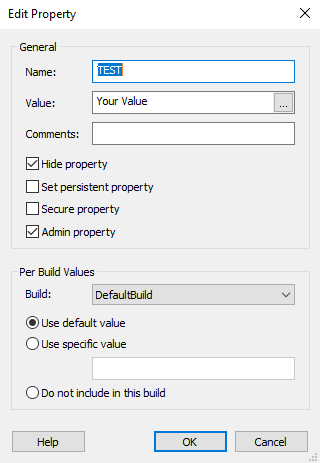
Efficient Property Editing Interface: Streamline Your Asset Management

Efficient Property Editing Interface: Streamline Your Asset Management
Table of Contents
- Introduction
- Registration
- Using Advanced Installer
- GUI
- Working with Projects
- Installer Project
* Product Information
* Resources
* Package Definition
* Requirements
* User Interface
* System Changes
* Server
* Custom Behavior
* Search
* Properties Page
* Properties Tab
* Edit Property Dialog
* Edit Property’s Value Source Dialog
* Edit Formatted Type Dialog
* Property Picker Dialog
* Project Path Variables Tab
* Global Path Variables Tab
* Custom Actions
* Table Editor - Patch Project
- Merge Module Project
- Updates Configuration Project
- Windows Store App Project
- Modification Package Project
- Optional Package Project
- Windows Mobile CAB Projects
- Visual Studio Extension Project
- Software Installer Wizards - Advanced Installer
- Visual Studio integration
- Alternative to AdminStudio/Wise
- Replace Wise
- Migrating from Visual Studio Installer
- Keyboard Shortcuts
- Shell Integration
- Command Line
- Advanced Installer PowerShell Automation Interfaces
- Features and Functionality
- Tutorials
- Samples
- How-tos
- FAQs
- Windows Installer
- Deployment Technologies
- IT Pro
- MSIX
- Video Tutorials
- Advanced Installer Blog
- Table of Contents
Disclaimer: This post includes affiliate links
If you click on a link and make a purchase, I may receive a commission at no extra cost to you.
Edit Property Dialog
Create or edit a property.

General
Name
In this field, you can specify the property name. When choosing the property’s name, you should also decide if the property is private or public .
Value
In this field, you can specify the property’s default value. Since this field is Pseudo-formatted, you can use some of the properties available when your custom property is initialized. To select one of them, type the “[“ character and select the “Property…” menu.
Comments
In this field, you can add useful information about the property as comments.
Hide Property
Prevents the property from being written into the log file. This may be used to prevent the installer from displaying passwords or other confidential information in the log file.
When the machine Debug policy is set to a value of 7, the installer writes the property in the log, even if the property is marked as hidden.
Set persistent property
If you enable this option, the property is stored in the registry and available in maintenance mode (repair, uninstall, etc.) and during the upgrade installation.
Secure property
Encrypts the value stored in the property.
Checking this option automatically adds the SecureProp.dll to the project and an internal custom action (AI_SecureProperty) that is executed during the install execute stage, during “Install Execution Stage -> Preparing” action group.
When this custom action runs, the current value of the property (to be secured) is encrypted and the property value is updated to the encrypted value.
The property value will be encrypted only after the install process moves beyond_”Preparing”_ action group. After this stage, if you need to decrypt the value of the secure property you should create your own set of custom action that calls the“GetRevealedTextLength” and “RevealText” functions of our SecureProp.dll.
To learn how to integrate this functionality with your application see the Secure Property how-tos .
Admin property
Allows the property to be saved during administrative installation ; meaning when the user installs from an administrative image, this value is used rather than the one stored in the MSI file.
Per Build Values
Configure the property’s value for each build.
This section is only available if your project contains multiple builds.
Build
Select a build from your project.
- Use the default value - use the default value for the selected build
- Use specific value - specify a different value for selected build
- Do not include in this build - don’t include a property in the selected build
Topics
- Edit Property’s Value Source Dialog
Set the value source for a property.
Did you find this page useful?
Please give it a rating:
Thanks!
Report a problem on this page
Information is incorrect or missing
Information is unclear or confusing
Something else
Can you tell us what’s wrong?
Send message
Also read:
- [New] Enhancing Video Success Top 8 YT Thumbnail Strategies
- [New] In 2024, Achieving Perfect Picture Quality on Zoom
- [New] In 2024, Craft Your Story with Immersive YouTube Video Editing Tips
- 2024 Approved Mastering Audio for Digital Unboxing Scenes
- Expert Guide: Setting Up Timed Radio Broadcast Captures
- Exploring File Attributes Through the Properties Dialog Box
- In 2024, Crafting Your Future A Guide to Prosperity in Graphic Designing
- In 2024, How To Change Your Apple ID on Apple iPhone 12 With or Without Password
- Manage Characteristics Through Edit Feature Options Window
- Smart Management of Ephemeral Data Storage Components in Tech Environments
- Star Wars Jedi: Fallen Order Won't Open - Now It Does!
- Streamlining Your Social Space Stop Following Steps
- Top-Rated Tools for Creating Stunning Transparent PNG Images: Essential Guides
- Understanding Essential Features of User Profiles
- Unleashing Wealth The Ultimate 13-Step Guide for Newbies on Reddit for 2024
- Title: Efficient Property Editing Interface: Streamline Your Asset Management
- Author: Michael
- Created at : 2024-10-07 16:05:35
- Updated at : 2024-10-10 22:20:28
- Link: https://fox-where.techidaily.com/efficient-property-editing-interface-streamline-your-asset-management/
- License: This work is licensed under CC BY-NC-SA 4.0.